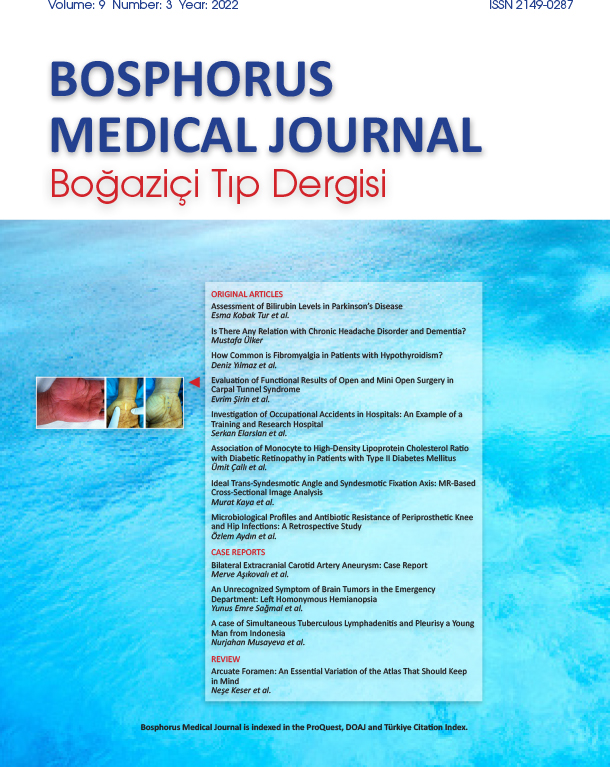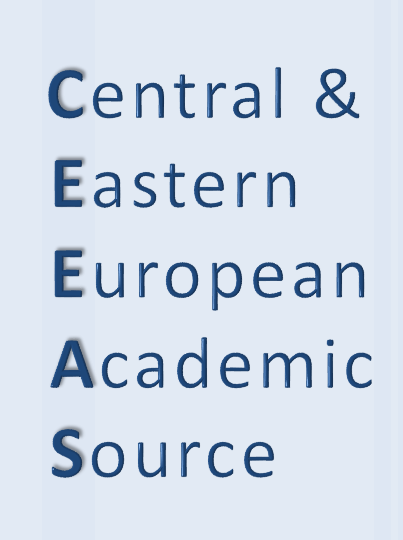Volume: 6 Issue: 1 - 2019
| EDITORIAL | |
| 1. | Editorial Eren Gözke Page I |
| ORIGINAL RESEARCH | |
| 2. | Comparison of Severity of Pain and Electrophysiological Severity Degree in Patients with Carpal Tunnel Syndrome Aybala Neslihan Alagöz, Yeşim Aras, Bilgehan Atılgan Acar, Türkan Acar doi: 10.14744/bmj.2019.35744 Pages 1 - 8 INTRODUCTION: Carpal tunnel syndrome (CTS) is the most common and best studied of all focal neuropathies. CTS is a clinical syndrome of numbness, tingling, burning, and/or pain associated with localized compression of the median nerve at the wrist. METHODS: A total of 49 hands of 32 patients who presented at the electrophysiology laboratory of the clinic due to suspected CTS were prospectively enrolled in the study. The patients were evaluated using the Leeds Assessment of Neuropathic Symptoms and Signs (LANSS) pain scale and a visual analog scale (VAS). The LANSS pain scale is an instrument designed for use in a clinical setting to identify patients whose pain is dominated by neuropathic mechanisms. VAS is a subjective register of pain: On a 100-mm horizontal scale, 0 indicates no pain, while 100 indicates maximum pain. The patients were diagnosed using electrophysiology and grouped as mild, moderate, and severe CTS. LANSS pain scale values above 12 and below 12 were compared according to the severity of CTS. The VAS was applied separately to the right hand and left hand. LANSS and VAS results were compared separately. RESULTS: The LANSS pain scale value was found to be 12 or more in cases of mild and severe CTS. The response to the LANSS question related to discoloration (item 2) was greater in the patients with a LANSS score ≥12 (p=0.008), and similarly, the allodynia (item 6) response was significantly higher in the same group (p=0.010). Except for these 2 items, there was no significant difference between patients with a LANSS score of <12 or ≥12 in terms of the results of the scale. The assessment of the electrophysiological severity of the disease and the VAS score was statistically significant in both the right and left hand (p=0.001, p=0.009). When the LANSS and VAS results were compared, a statistical correlation was identified in the right hand between LANSS discoloration (item 2) (p=0.029) and the total LANSS score (p=0.049). DISCUSSION AND CONCLUSION: Other than allodynia, the LANSS pain scale did not show any significant correlation with electrophysiological severity in patients with CTS. In the group with a LANSS score of ≥12, the responses to item 2 (discoloration) and item 6 (allodynia) were significantly higher. VAS was statistically more significant for identifying electrophysiological severity. These results indicate that the use of VAS in daily practice is confirmed. Additional studies conducted with more detailed tests and a larger number of patients will enable patient follow-up treatment without the need for repeated electroneuromyography examinations. |
| 3. | Ulcerative Colitis and Neopterin: Related? Beşir Kesici, Gülden Yürüyen, Hale Aral doi: 10.14744/bmj.2019.38258 Pages 9 - 13 INTRODUCTION: Ulcerative colitis (UC) is a chronic inflammatory bowel disease that invades the colon mucosa and progresses with remissions and exacerbations. Neopterin is a biochemical marker of cell-mediated immunity. Studies have demonstrated increased levels of neopterin in inflammatory bowel diseases. The aim of this study was to examine the relationship between the Truelove-Witts criteria and the level of neopterin in UC patients, as well as the usefulness of neopterin in determining the activity of the disease. METHODS: Thirty-three patients who were followed-up for UC in the gastroenterology clinic of a single hospital were enrolled in the study and divided into 3 groups: mild, moderate, and severe UC, according to the Truelove-Witts activity index. A control group of 43 healthy individuals was also included in the study. The neopterin level of the patient and the control groups was examined and the relationship was statistically analyzed. RESULTS: No statistically significant difference was detected in the median neopterin level between the patient and the control groups. DISCUSSION AND CONCLUSION: These results demonstrated that the serum neopterin level remained unchanged in patients with UC when compared with the control group, and that age and gender did not have any specific impact on this outcome. |
| 4. | Comparison of Conjunctival Autograft and Primary Excision for The Surgical Treatment of Primary Pterygium Ali Olgun, Aylin Ardagil Akçakaya, Dilek Güven doi: 10.14744/bmj.2019.50469 Pages 14 - 17 INTRODUCTION: This study is an evaluation of the postoperative results of the conjunctival autograft (CA) and primary excision (PE) surgical techniques. METHODS: Primary pterygium patients who underwent PE surgery and free limbal CA surgery were compared retrospectively in terms of age, gender, pterygium type, the presence of recurrence, recurrence time, and recurrence time (months). A total of 94 cases of primary pterygium were investigated: In all, 40 were treated with PE and 54 with CA. RESULTS: In the PE group, recurrence was detected in 9 of 40 patients (22.5%), while it was seen in 2 of 54 patients (3.7%) in the CA group. The recurrence rate in the PE group was statistically significantly greater than that of the CA group (p=0.005). When we assessed survival time (months) without recurrence, it was statistically significant that the length of time before recurrence was longer in the CA group than in the PE group (16.55±7.95 months, 20.33±5.12 months, respectively; p=0.01). DISCUSSION AND CONCLUSION: CA is an effective and reliable method of primary pterygium surgery. We do not recommend the CA technique in filtration surgery candidates. |
| 5. | Do Plates Used for Internal Fixation During Fracture Healing Maintain Their Metal Structure and Function? Barış Yılmaz, Baran Kömür, Evrim Şirin, Erdem Aktaş, Cevat Yılmaz, Nurettin Heybeli doi: 10.14744/bmj.2019.02996 Pages 18 - 21 INTRODUCTION: Dynamic compression plates used in fracture fixation were divided into 2 groups according to the location of use: upper extremity (Group 1) and lower extremity (Group 2). The metallic structure and properties of the plates were evaluated using radiographic, penetrant, and chemical analysis. METHODS: There was no statistically significant difference between the 2 groups in terms of patient sex, mean age, side distribution, or removal time (p>0.05). RESULTS: No instance of microfracture was observed in the radiological and penetrant analysis of the plates. There was no metal loss or metal ratio change observed in the chemical analysis. There appears to be no additional benefit of durability based on the metal compound and no damage was observed during an appropriate period of use. DISCUSSION AND CONCLUSION: The successful use of plates in weight-bearing areas as well as non-weight-bearing areas with no damage may lead to further research and the production of lower cost alternatives that are equally durable. |
| 6. | Doppler Ultrasonography in Primary Open-Angle and Normal Tension Glaucoma Patients Esin Derin Çiçek, Zeynep Acar, Bülent Saydam doi: 10.14744/bmj.2019.82574 Pages 22 - 28 INTRODUCTION: This study was designed to evaluate hemodynamic alterations in the retrobulbar blood flow in primary open-angle and normal-tension glaucoma patients using Doppler ultrasonography (US) and to emphasize the importance of diagnostic imaging and vascular factors in the etiology. METHODS: A total of 98 eyes of 50 patients were examined for the study. The control group consisted of 14 normal cases. The patient groups were comprised of 25 patients with primary open-angle and 11 patients with normal-tension glaucoma. All of the examinations were performed using a multifrequency (5-7.5-10 MHz) linear transducer and a Toshiba PowerVision 7000 SSA-380A color Doppler US device (Toshiba Corp., Tokyo, Japan). The peak systolic velocity and resistive index values of the ophthalmic artery, central retinal artery, and temporal posterior ciliary arteries were examined. RESULTS: There was no significant difference between the groups in terms of age and gender distribution, and no difference in peak systolic velocity or resistive index between the 2 eyes. In both glaucoma groups, the peak systolic velocity and resistive index of the ophthalmic artery and the peak systolic velocity in the central retinal artery showed no statistically significant difference with those of the control group. The resistive index of the central retinal artery was higher in the glaucoma patients compared with the control group. In the posterior ciliary arteries, the peak systolic velocity was lower and the resistive index was higher in the glaucoma group than in the control group. No statistically significant difference was found between the 2 glaucoma groups in any parameter. DISCUSSION AND CONCLUSION: The findings in the central retinal artery, and especially in the posterior ciliary arteries, support the theory that changes in vascular hemodynamics can play a role in the etiology of glaucoma. Color Doppler US is a safe, noninvasive, contrast-free, radiation-free, and reproducible method to evaluate retrobulbar blood flow. |
| 7. | Overall Survival Results with Surgical Treatment After Neoadjuvant Chemotherapy in Local Invasive Gastric Cancers Gökhan Ertuğrul doi: 10.14744/bmj.2019.07279 Pages 29 - 32 INTRODUCTION: Gastric cancer is a very common and fatal cancer. The only known curative treatment is radical gastrectomy. This retrospective study compared the overall survival results of surgical treatment after neoadjuvant chemotherapy and standard surgical treatment. METHODS: The records of 90 patients from a single center who had locally invasive gastric cancer were evaluated retrospectively. Of those, 45 patients (50%) underwent neoadjuvant chemotherapy and surgical treatment. RESULTS: Patients who underwent surgical treatment after neoadjuvant chemotherapy for locally invasive gastric cancer were found to have a general survival time of 16.6 months, while it was 15.6 months for those who pursued standard surgical treatment. DISCUSSION AND CONCLUSION: In this study, there was no significant difference in terms of overall survival between surgical treatment after neoadjuvant chemotherapy and standard surgical treatment for patients with gastric cancer. |
| CASE REPORT | |
| 8. | Complicated Acute Appendicitis Accompanying Amyand's Hernia Anıl Ergin, Yalın İşcan, Birol Ağca, Kemal Memişoğlu doi: 10.14744/bmj.2019.14622 Pages 33 - 35 Amyand's hernia is a very rare form of hernia in the inguinal hernia sac. Presently described is a case of Amyand's hernia complicated by acute appendicitis. A 62-year-old male patient presented at the emergency department with complaints of pain in the right inguinal region. He had acute appendicitis in the right inguinal hernia. An appendectomy was performed. Due to the high risk of infection, a mesh application was avoided. The patient was discharged on the first postoperative day. The incidence of Amyand's hernia accompanied by acute appendicitis is quite low. The current literature generally does not recommended an Amyand's hernia mesh repair with a laparoscopic appendectomy in the presence of acute appendicitis. In this case, the appendectomy was completed laparoscopically and the hernia sac was repaired intraperitoneally with primary suturing. |




















